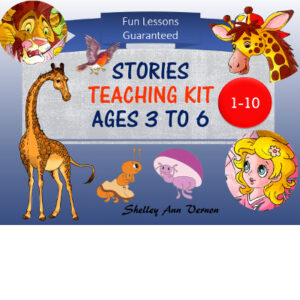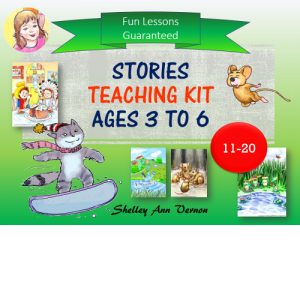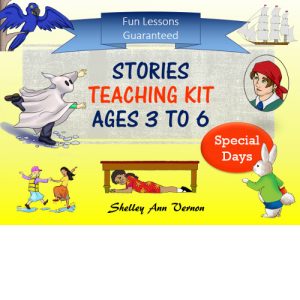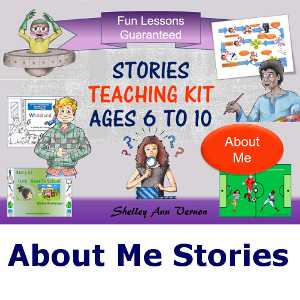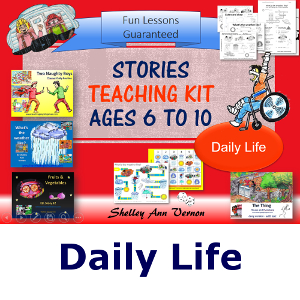Do you want to start using stories in the preschool ESL classroom, but you don't know where to start?
Learning English through stories is such a powerful teaching tool. Seriously, you’d be mad not to include them in your mix of fun games, songs, and role-plays. Children are captivated by stories and can internalise vocabulary and the structure of language while listening to them. So whether you are reading a classic book, making up a narrative as you go along, or designing a story specifically for a particular lesson, you will want to be sure to include them in ESL lessons every day.
Intrinsic motivation
One of the reasons learning English through stories works so well with young learners is intrinsic motivation. Intrinsic motivation is the theory that people are motivated by internal factors. Simply put, this means that young children must enjoy their classes to be inspired to participate and learn.
As children already love listening to stories, you are halfway there to intrinsically motivating them. The rest depends on how good the story is, how interesting and colourful the illustrations are, and how you tell it.
Ways of learning English through stories
There are so many ways to use stories in the classroom that the possibilities are practically endless. For example, here are some ideas and tips to help you effectively use stories in your ESL classroom:
Teach Vocabulary
Before you use a story, it is beneficial to teach the students the target vocabulary words since this will help them follow the narrative. Therefore, the tale can serve as a basis for learning vocabulary words. However, it goes deeper because students will not just “learn” the words; they will notice how they are used and hear them in context. This approach is clearly better for students than simply memorizing a list of words.
Be Creative
Whenever you tell a story, allow your creativity to show through. Have fun with it and go with the flow. For example, make animal sounds, change your voice, sing short songs, and, most of all, use gestures. Next, have the children join in with animal sounds, songs, and gestures, or give them props to touch during the storytelling. This physical engagement is known as total physical response or TPR, which engages the children fully and allows them to feel or relate more deeply to the words, so they are more likely to remember them.
Add Variety
Stories create variety and can be the focal point of a lesson.
As preschoolers have short attention spans spending five minutes on a story is a way to add variety. In addition, a story is also calming after a more boisterous physical activity, so you can use it to allow everyone enough time to settle down before moving on to something else. Next, using games to pre-teach vocabulary is a fun way to learn. Finally, read the story and then play games and activities related to the story.
Choose Suitable Stories
Learning English through stories successfully requires narratives that correspond well to students’ ages and language levels. For example, beginners need super simple texts with few words and repetitive language patterns. In addition, the illustrations should depict the events in the story clearly and colorfully to help children understand and engage them visually. Please see this post for a free story ideal for preschoolers learning English.
Story activities
Stories are a great jumping board for other activities. For example, you can create activities and games based on the theme and vocabulary in the story to give pupils more opportunities to practise the language. Here is a sampling of activities you could do following a story:
- Give each student a picture that depicts one of the story’s events and have them line up in order of the narrative.
- Have students think of a title for the story. Allow as many titles as possible.
- Repeat quotes from the dialogue, then ask students, “Who said it?”
- Leave off the ending and have the students predict what they think will happen. Then, read the close of the story.
- Encourage the children to look for patterns in the story. Have them guess, for example, what the character will say if there is a pattern in what the character says.
- Teach a song that goes with the story’s theme, or invent a tune yourself. Chant sentences from the narrative using rhythm and clapping. Keep the chants simple, repeat them in different voices, and encourage the children to join in. Even if the children only join in with clapping rhythms at first, that is a good start.
- Teach actions to go along with the songs.
- Let them act out parts of the story.
- Set up stations that allow them to dress up as characters in the story and do things the characters did. So, if the characters in the story decorate cookies, make time to decorate cookies. If making real biscuits is not practical, a cookie craft would be fine instead.
- Give the students three events in the story and ask them what came first.
- Have students draw a picture about their favourite part of the story and then explain it to the class, simply in English or more fully in the child’s L1.
- Let students describe a similar experience they might have had.
What if you do not speak the children’s Native Language?
If you are teaching abroad and do not speak the language, everything below applies to you. First, remember to reassure the children by smiling at them and looking happy and confident. If you look like you know what you are doing, the children will believe in you.
Teach useful commands
Use simple words and short sentences to explain basic actions that you will need the children to understand, such as “sit on the floor” or “make a circle.” Use chanting, singing, clapping while you repeat the command over and over. Use demonstration, so the children know what you mean.
Stick to those words and phrases over time and build on them. Use games with simple rules that you can demonstrate, pre-teach single vocabulary words that occur in the story, and make sure all children can see the illustrations when you tell the story to help them understand.
Great resources for learning English through stories
Learning English through stories gives you so many fun things to do in the classroom. Just let your imagination run free, and soon the creativity of your students will follow! If you would like ideal games and ready-made illustrated stories, please visit the link here below.
ABOUT THE AUTHOR: Shelley Vernon has inspired thousands of ESL / TESOL teachers with her games. Try her free games and receive a free story with activities written specially for preschool and primary school children learning English. Then, order her story teaching kits to save time and be a successful teacher.
-
Preschool
ESL Preschool Stories 1-10 Teaching Kit + PowerPoints
Rated 0 out of 5€39.97Original price was: €39.97.€29.33Current price is: €29.33. Add to cart -
Preschool
ESL Preschool Stories 11-20 Teaching Kit + PowerPoints
Rated 0 out of 5€39.97Original price was: €39.97.€29.33Current price is: €29.33. Add to cart -
Preschool
Special Days Stories Teaching Kit + PowerPoints
Rated 0 out of 5€39.97Original price was: €39.97.€29.33Current price is: €29.33. Add to cart
-
Primary
About Me Stories Teaching Kit + PowerPoints
Rated 0 out of 5€49.97Original price was: €49.97.€33.97Current price is: €33.97. Add to cart -
Primary
Daily Life Stories Teaching Kit + PowerPoints
Rated 0 out of 5€49.97Original price was: €49.97.€33.97Current price is: €33.97. Add to cart

